
By Craig Moyer - Western Washington University
December 02, 2014
Overview of project area and the remotely operated vehicle, Jason. Video courtesy of Submarine Ring of Fire 2014 - Ironman, NSF/NOAA, Jason, Copyright WHOI. Video produced by Saskia Madlener. Music by Charlie Brooks. Download (mp4, 24.3 MB)
Our first Jason dive (J2-797) was to the Southern Mariana Back-arc spreading center, also known as the Malaguana-Gadao Ridge.
The name of this ridge refers to a Chamorro (the native Polynesians on Guam) legend about a contest of strength between two chiefs (Malaguana and Gadao) when they both jumped into a canoe and began paddling in opposite directions and, much like the two pull-apart geologic plates on either side of this ridge, the canoe separated.
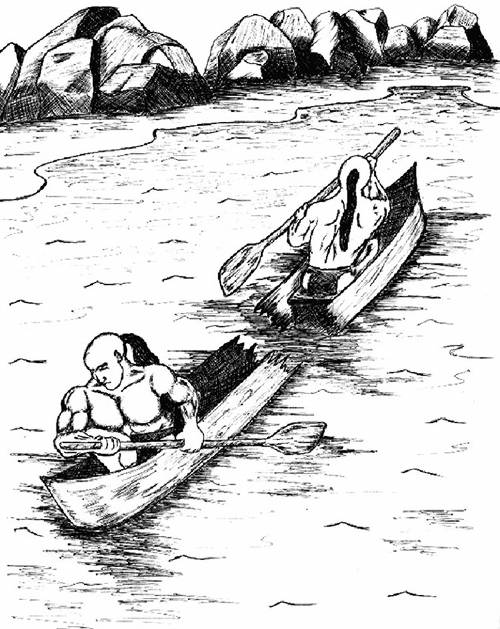
Malaguana and Gadao, two chiefs competing in a contest of strength in a Chamorro legend. Image courtesy of Submarine Ring of Fire 2014 - Ironman, NSF/NOAA. Download image (jpg, 75 KB).

Saipan-da! Image courtesy of Submarine Ring of Fire 2014 - Ironman, NSF/NOAA. Download image (jpg, 93 KB).
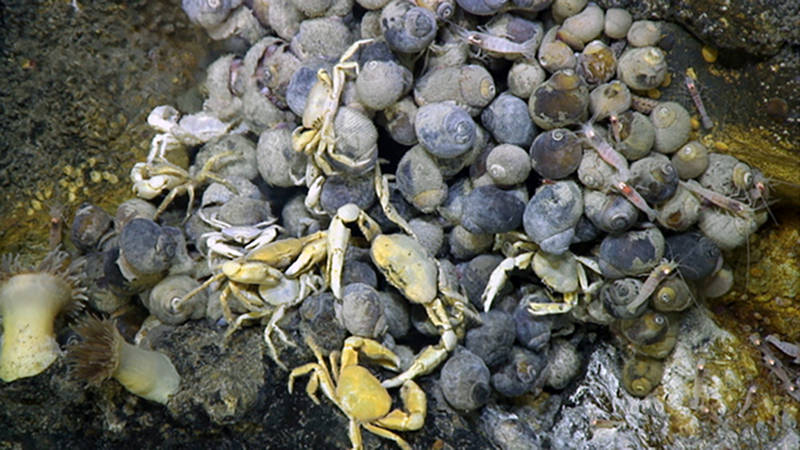
Snails, crabs, shrimp and anemonies compete for space at Snail hydrothermal vent site. Image courtesy of Submarine Ring of Fire 2014 - Ironman, NSF/NOAA, Jason, Copyright WHOI. Download larger version (jpg, 2.0 MB).
We began our dive at a vent site atop this ridge discovered in 2003 by Patty Fryer and Geoff Wheat known as Snail Vent, named after the rather large deep-sea vent snails (Phymorhynchus and Alviniconcha species) that occur there. There are also large patches of iron-based microbial mats, which was the primary reason behind our interest in this site. We collected vent fluid and microbiology samples as well as conducted some photo surveys of the area.
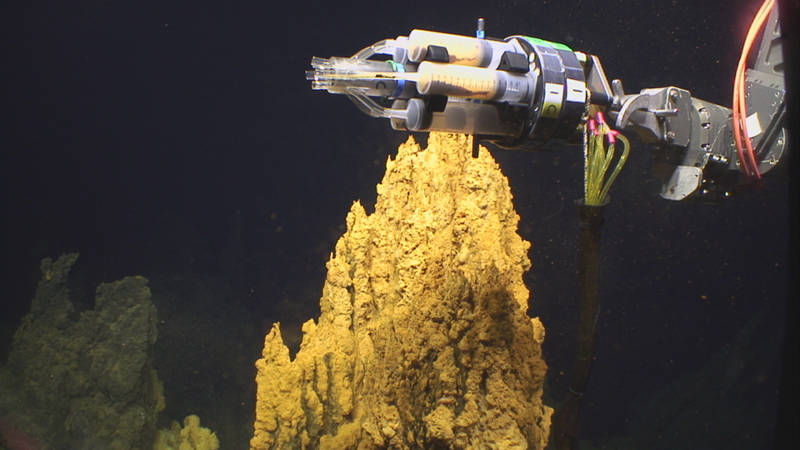
The Jason manipulator arm holds the Bio-Mat sampler, consisting of six syringe-like tubes that can be triggered individually. Image courtesy of Submarine Ring of Fire 2014 - Ironman, NSF/NOAA, Jason, Copyright WHOI. Download larger version (jpg, 1.5 MB).
Our main sampling tool was the Bio-Mat Sampler, which allows us to collect discrete fine-scale mat samples so that we can analyze the different microbial communities that make their home in these mats. We also use something called a scoop-sampler to directly “scoop up” pieces of still-intact mat so that we can better study the different layers as they naturally occur, much like looking at the different floors in a condominium and seeing who is home.
We also use tools like the Hot Fluid Sampler (aka, the Beast), Gas-tight samplers, and Major water samplers to collect vent effluent to analyze the fluid geochemistry. In that way, we can see what is on the “Metabolic Menu” or in other words what food resources are fueling the chemosynthetic growth of our microbial mats.
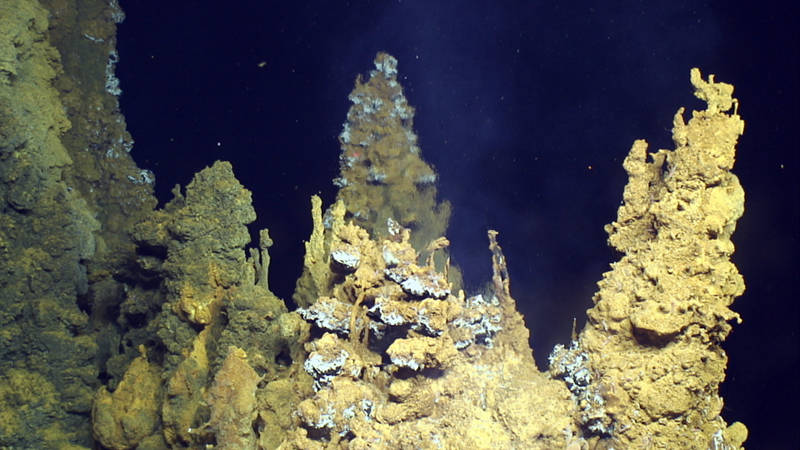
Sulfide chimneys coated with iron-based microbial mat at the Urashima vent site. Image courtesy of Submarine Ring of Fire 2014 - Ironman, NSF/NOAA, Jason, Copyright WHOI. Download larger version (jpg, 1.8 MB).
Next we were off to our second vent site of interest, a nearly five-kilometer underwater journey to an off-axis vent area called “Urashima” named after the Japanese autonomous underwater vehicle that was mapping plumes in the area and discovered these vents in 2009. This site was then later confirmed with a pair of Shinkai 6500 manned-submersible dives in 2010. This area of venting also supports the growth of extensive iron-based microbial mats scattered around a central smoker known as “Baltan Chimney” that is expelling clear vent fluids in excess of 200°C, or twice that of boiling water at sea level.
While at this site, we discovered two new and very distinctive iron-mat mounds that exhibited diffuse venting. We named one of them “Saipanda Horn,” and we then conducted quite a bit of microbiological and geochemical sampling. The Saipanda is a mythical beast from Saipan that has an orange-yellow horn, just like the color of the mats we found.
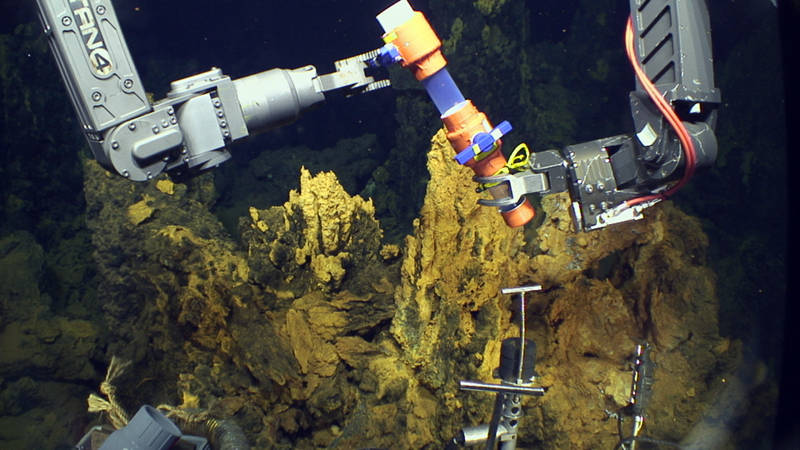
Jason opens a valve at the top of one of the scoop samplers before taking a sample of microbial mat from the chimneys in the background. Image courtesy of Submarine Ring of Fire 2014 - Ironman, NSF/NOAA, Jason, Copyright WHOI. Download larger version (jpg, 1.7 MB).
To finish off our dive, we conducted a detailed photo survey of the ornate “Baltan, Shar-pen and Eleking Chimney” structures made from iron-sulfide minerals coming out of solution when the hot vent water contacts cold seawater. This chimney structures were over 10 meters tall.
Footage from the dives at Snail Vent and Urashima. Video courtesy of Submarine Ring of Fire 2014 - Ironman, NSF/NOAA, Jason, Copyright WHOI. Video produced by Saskia Madlener. Music by Charlie Brooks. Download (mp4, 20.3 MB)
Once the collected samples make it back up to the ship, we then begin to process them by first examining each one under the microscope, which is no small feat on a moving ship at sea. Then we perform a variety of experiments, like the one Sean McAllister is doing to monitor the mat communities’ ability to continue to grow and oxidize iron. Finally, we put some of the mat material into an ultrafreezer, which is very, very cold, to preserve the microorganisms till we rupture their cells and extract DNA and RNA. We do this so we can then perform some additional molecular microbiology techniques, like Heather Fullerton’s metagenomics or Kevin Hager’s DNA fingerprinting, back in the laboratory.
First sample recovery. Video courtesy of Submarine Ring of Fire 2014 - Ironman, NSF/NOAA, Jason, Copyright WHOI. Video produced by Saskia Madlener. Music by Charlie Brooks. Download (mp4, 21.6 MB)